Signage serves as a key aspect of branding and communication, with its 7.9% CAGR in Australia. So, its durability directly impacts its value. Understanding the lifespan of your window signage is crucial for making informed decisions about materials, installation, and maintenance.
For example, vinyl window signage can last up to 12 years, depending on its type. On the other hand, aluminium window signage can last up to 10 years or more. You can also expect a 10-year lifespan for wood signage.
In this article, we’ll explore the factors affecting signage longevity and the lifespan of various materials used in creating window signage.
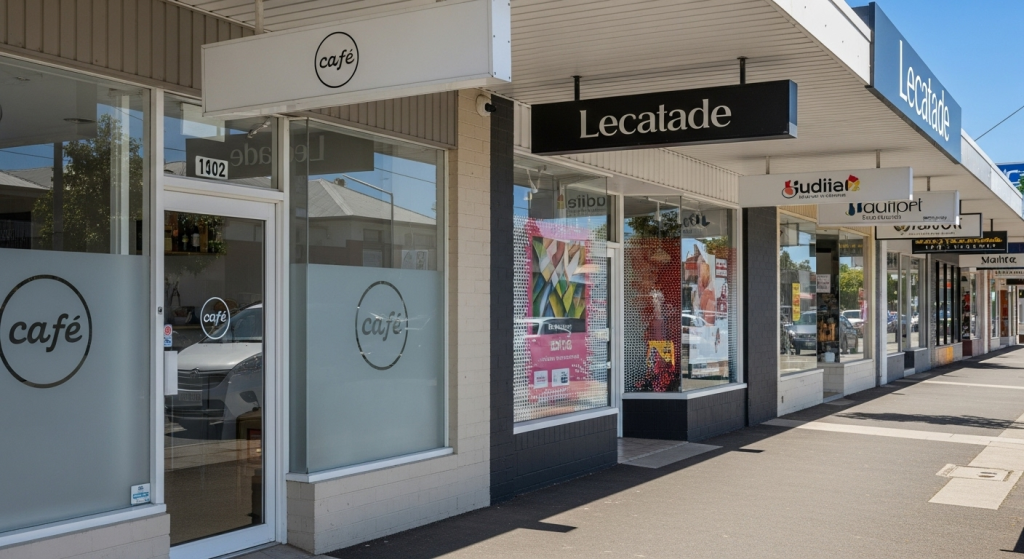
# Window Signage Lifespan Regarding Material Types
Window signage is made of different materials. Different materials offer different levels of lifespan. Below is a breakdown of the common signage material longevity for different materials.
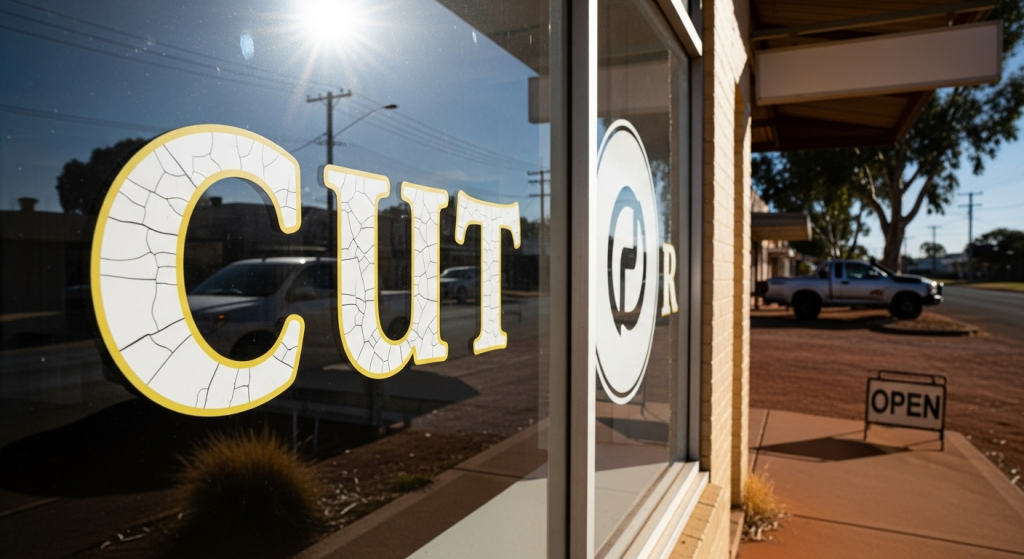
#1 Vinyl Signs
Vinyl is the most popular and most widely used window signage material. The global market size of vinyl signage in 2020 was $3.16 billion. The CAGR(compound annual growth rate) is 4.6% between 2021 and 2028.
They are also known as PVC window signs since vinyl signs are made of PVC. PVC has a tensile strength of 55–80 Mpa.
There are two main types of vinyl used. They are cast and calendered vinyl. So, when you compare cast vs. calendered vinyl, the cast vinyl’s longevity can range between 5 and 12 years.
On the other hand, calendered vinyl is common, and it can last up from 5 to 7 years. You can expect the durability of vinyl lettering to be 5 to 7 years.
However, adding UV-resistant coatings can prevent fading and cracking. This is especially true for outdoor vinyl signs. UV-resistant signage can extend its lifespan more than usual.
Ultimately, vinyl signage durability is robust, and it is a perfect choice for window signage.
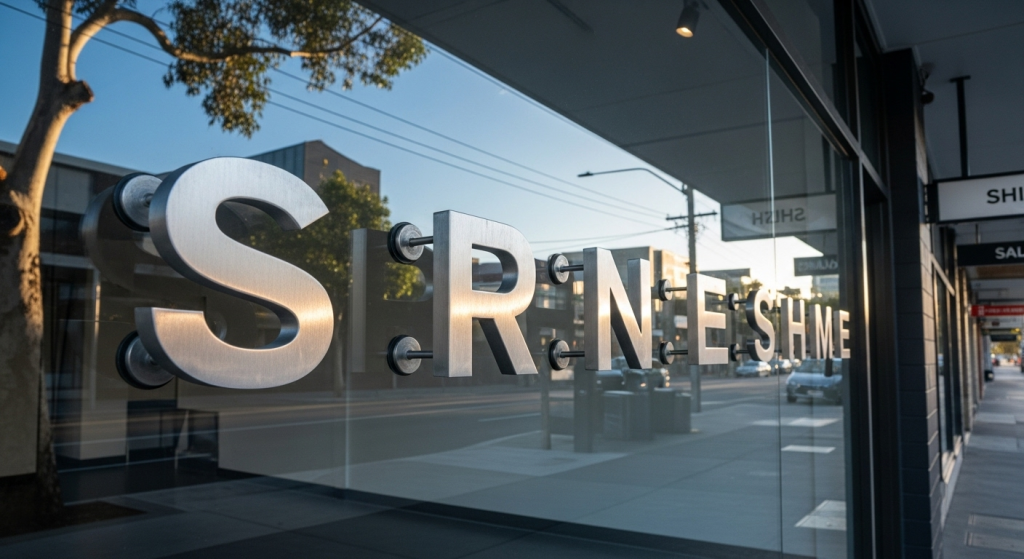
#2 Metal Signs
Aluminium Window Signage
Aluminium is one of the most corrosion-resistant metals. The aluminium itself has a very low corrosion rate, ranging from 0.03 to 4 µm per year.
However, the lifespan of aluminium signs is expected to be 7 to 10 years or more before they start fading.
On the other hand, aluminium composite material (ACM) has a very low water absorption rate. This ranges only from 0.18% to 0.25%.
When used for exterior window signage, it can last 5 to 7 years before fading. For interior signs, this can go up to 10 years.
Steel
Treated steel signs resist rust and can last 5–8 years, though they require regular maintenance to avoid corrosion.
Brass
Brass is known for its aesthetic appeal. Brass window signs can last 8–12 years if properly cared for, though they may tarnish over time.
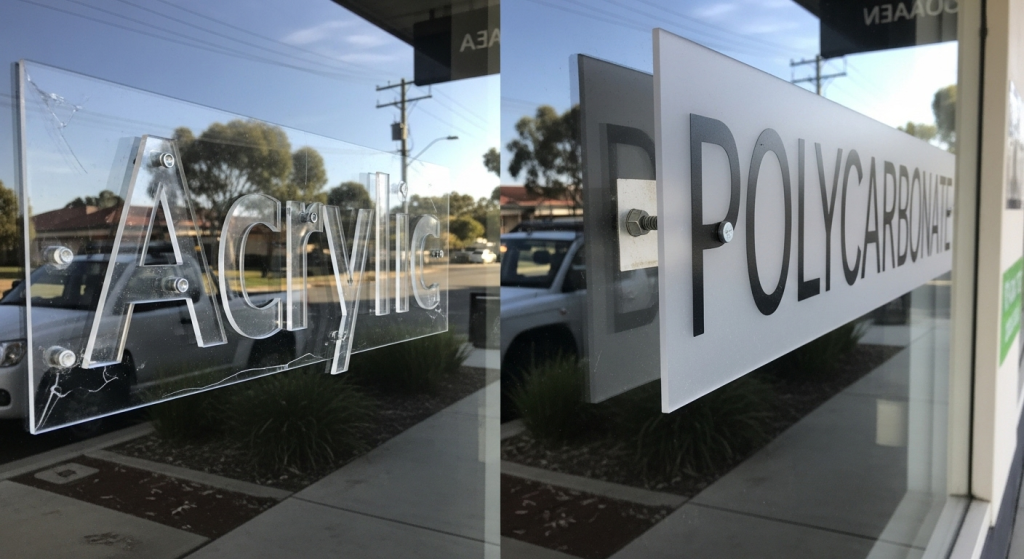
#3 Acrylic and Polycarbonate Signs
Polycarbonate signs and acrylic sign durability can reach 5–10 years.
Both materials are UV-resistant, offering excellent outdoor performance. However, they are prone to scratching if mishandled. Also, environmental exposure can impact durability.

#4 Mesh Signs
Mesh signs are typically made of 30% mesh and 70% vinyl. With proper installation and maintenance, the mesh can last 10 to 20 years.
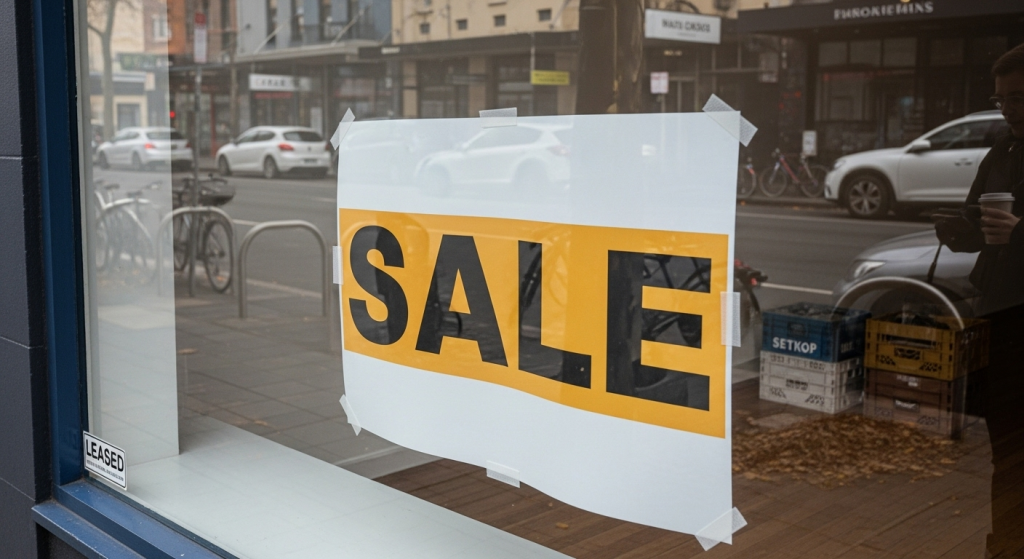
#5 Foamboard Signs
Foam Board or foam core board signs are actually used for short-term signs. So, you can expect 1 year of lifespan for foam board signs. However, most businesses don’t use these signs for that long. They are mostly used in events.
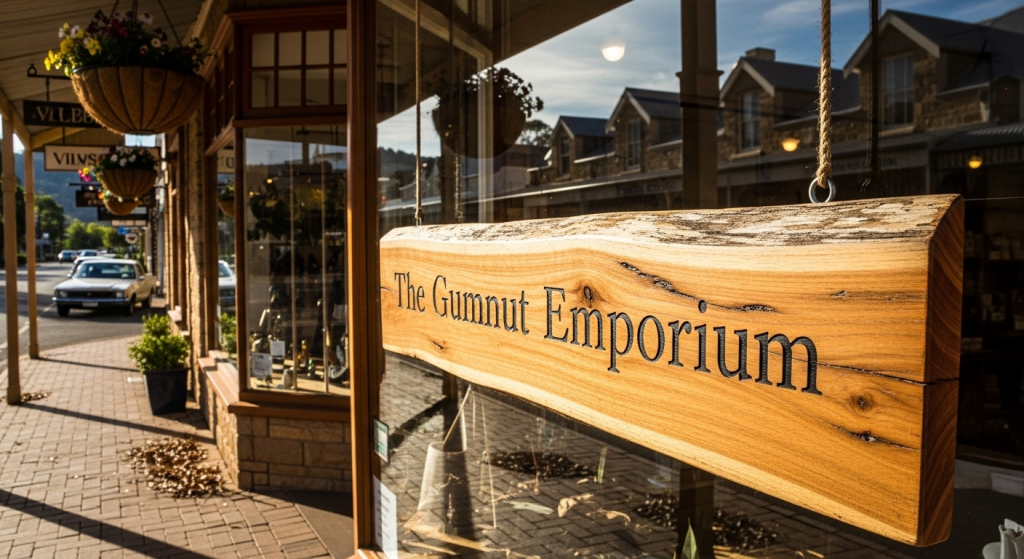
#6 Wooden Signs
Wooden signs can last up to a decade if treated well before installation. However, the normal lifespan of wood signs isn’t less than 10 years. However, the longevity also depends on the wood type as well.
Factors Influencing Signage Longevity
Different factors impact the lifespan of window signage. We have discussed the factors below.
#1 Environmental Impacts on Signs- Indoor vs. Outdoor Signage
Environmental factors are one of the most vital factors influencing the lifespan of window signage. For example, Brisbane has higher humidity. The humidity of Brisbane ranges from 65% – 70% from January to March.
When considering the environment, the placement of window signage significantly impacts its lifespan.
Impact of Indoor Signage on Lifespan
Window signage placed indoors enjoys a controlled environment. As a result, it contributes to a longer lifespan.
- It remains safe from UV rays since not being exposed to direct sunlight.
- Indoor temperature doesn’t fluctuate extremely. So, it minimises the risk of warping, cracking, or adhesive failure.
- The minimum exposure to rain, wind, and pollutants preserves their structure and appearance.
Impact of Outdoor Signage on Lifespan
One of the harsh conditions with outdoor window signage is fading. Brisbane has harsh sunlight that emits UV rays most of the year. Over time, UV rays break the pigments in the materials. This leads to a loss of vibrancy and readability of the ad content.
Rain, storm, wind, temperature fluctuation, etc., are also common here.
- Rain, wind, and temperature fluctuations can wreak havoc on signage. Rain accelerates the rust and water damage in metals. These also can cause swelling or warping in wooden signs.
- Wind adds physical stress, particularly in rigid materials. This leads to cracks or displacement.
- Extreme temperature shifts can make plastics brittle or cause adhesives to fail prematurely.
However, different states of Australia have different environmental conditions. So, weather impacts will be different in all the places.
#2 Maintenance Practices
Regular cleaning and maintenance extend the lifespan of window signage. It is vital to keep the signs in good condition.
Avoid the use of abrasive cleaners that may damage the surfaces, like coating and finishes of the signs.
#3 Sign Installation Quality
Installation quality is one of the big factors that influences window signage lifespan. Proper installation ensures the stability and extends the lifespan of your window signage.
Poor installation, such as uneven placement or using low-grade adhesive, can lead to premature wear and tear. This is especially true for outdoor signs.
#4 Material Quality and Compatibility
The choice of material significantly impacts how well a sign withstands wear and tear. If you use high-grade, UV-resistant signs, they will last longer than poorly graded ones.
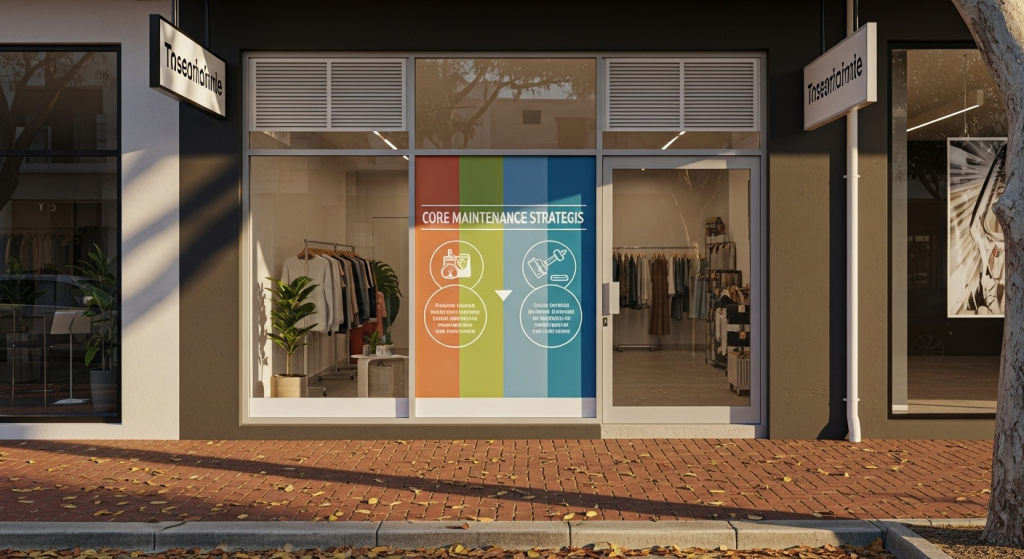
Tips to Increase the Lifespan of Window Signage
Investing in quality signage is the first step to increasing the lifespan of your window signage. Here are the factors you should consider if you want to increase the lifespan of your window signage to its maximum.
#1 Choose High-Quality Materials Suited to the Environment
Signage durability starts with the material. Weather-resistant materials such as vinyl or aluminium should be used to make signs that are meant to be used outside.
Because indoor signs are protected from the weather, there is greater freedom in selecting the materials. They provide choices like foam board and acrylic.
So, you can ensure longevity and avoid early wear by choosing materials that are especially appropriate for the sign’s placement.
UV-resistant coatings and anti-fading solutions are highly effective in preventing damage to window signage. The UV-resistant coating includes-
- clear coat,
- a ceramic coating,
- formulated inks and dyes
- plastic lamination
- fluoropolymers like PVDF (polyvinylidene fluoride) coating, etc.
These coatings act as a protective barrier, reflecting harmful UV rays and maintaining the sign’s colour vibrancy. They also enhance durability, shielding materials from the degrading effects of weather exposure.
Adding such coatings is an essential step for outdoor signage. This ensures it remains visually appealing and functional for as long as possible.
#2 Opt for Professional Installation
A sign’s structural integrity can be greatly impacted by how it is erected, as we previously discussed. Expert installers make sure that the proper fasteners, adhesives, and methods are used to secure the signage.
By doing this, damage-causing stress points are reduced. Also, professionals guarantee correct alignment and placement. These prevent needless exposure to damaging factors like strong winds or direct sunlight.
You can rest assured that professional installation will significantly increase the lifespan of your window signage.
#3 Properly Maintain Signs Regularly
Consistent maintenance plays a crucial role in extending the lifespan of your signage. Regular cleaning removes dirt, grime, and pollutants. Otherwise, these can degrade materials over time.
Gentle cleaning with non-abrasive products helps window signs to maintain the finish. You can use products like-
- Diluted dish soap
- Ammonia-free glass cleaners
- Isopropyl alcohol with less than 70% concentration
- Streak-free window cleaners
- Microfiber clothes
- Soft sponges
- Cotton clothes
- Soft bristle brushes, etc., for harmless cleaning.
Periodic inspections allow you to catch early signs of wear, such as fading, peeling, or cracking. Protective coatings can shield them from UV rays and weather-related damage. And this is particularly impactful for outdoor window signs.
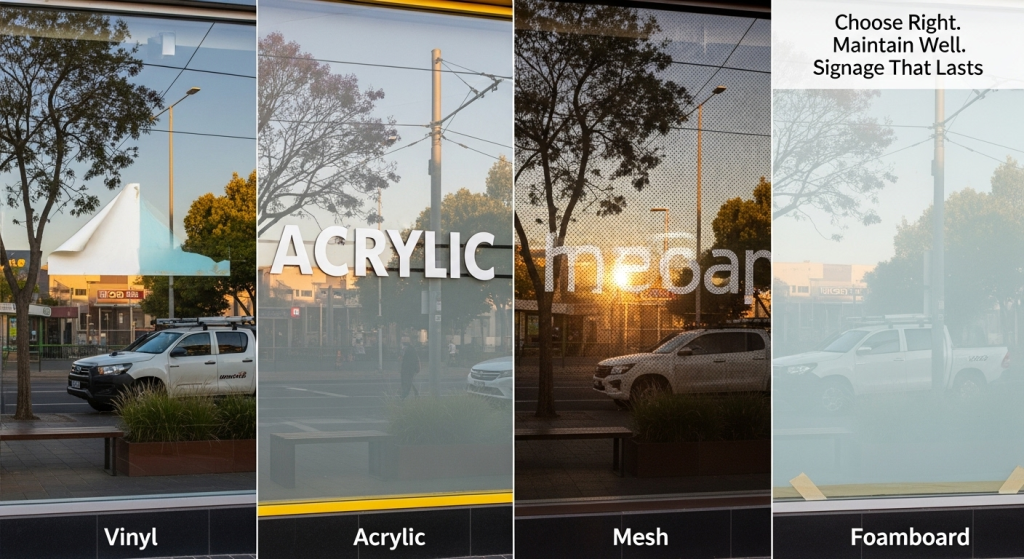
Final Words
Investing in durable signage ensures better cost-effectiveness over time. It also maintains brand consistency as well. Understanding the lifespan of materials can help businesses make smarter decisions for their signage needs.
At Signage 4Business Group, we specialise in designing and installing custom signage solutions that last. From material selection to professional installation, we ensure your signs make a lasting impact. Trust us to deliver high-quality, durable signage tailored to your business needs.